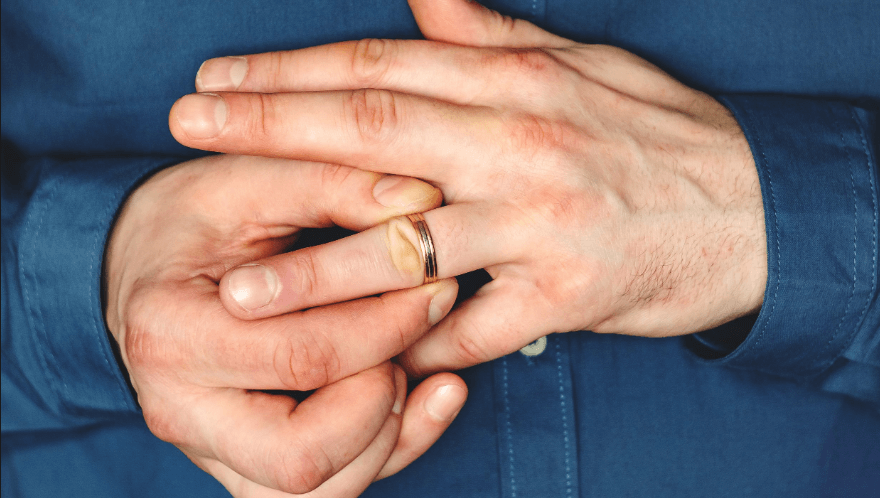📑Table of Contents:
- Why do Rings Get Stuck?
- Lubrication Technique
- Cold Water and Elevation
- Dental Floss or String Technique
- Windex Method
- Tips to Prevent Future Incidents
- Additional Advice for Sensitive Skin
- Advanced Techniques and Professional Tips for Stuck Rings
- Consideration for Chronic Swelling
- Maintenance and Care for Rings
- When to Seek Professional Help
Finding yourself with a ring stuck on your finger is a surprisingly common issue that can cause unnecessary stress. Whether it’s due to a hot day, swelling, or a size change, the feeling of a ring that won’t budge is uncomfortable at best. But don’t worry; several safe and straightforward methods exist to free your finger without harming your skin or the ring.

Why do Rings Get Stuck?
To effectively remove a stuck ring, it’s important to understand the common causes:
- Swelling: Changes in body temperature, fluid retention, or medical conditions can cause fingers to swell.
- Improper Sizing: A ring that doesn’t fit properly is more likely to get stuck.
- Inflammation: Any form of inflammation or injury to the fingers, such as sprains, fractures, or even severe arthritis, can cause swelling, leading to rings stuck.
- Joint changes: Conditions like arthritis can change the shape of joints, making it difficult for rings to slide over knuckles.
- Accumulation of Substances: Lotions, soaps, and other substances can build up under a ring, making it harder to remove.
Lubrication Technique
Materials Needed:
- Lubricants include soap, oil (cooking or baby oil), petroleum jelly, or hand lotion.
Steps:
- Apply the lubricant: Cover the affected finger and the ring thoroughly with the lubricant.
- Twist and pull: Gently twist the ring back and forth while slowly pulling it over the knuckle.
Tip: Warming the lubricant slightly can sometimes help, making the skin more pliable.
Cold Water and Elevation
Materials Needed:
- Ice water or an ice pack.
Steps:
- Elevate and ice the finger: Hold your hand above your heart for a few minutes, then apply an ice pack or soak the finger in ice water for up to 10 minutes.
- Dry and lubricate: After icing, quickly dry the finger to remove moisture and apply a lubricant.
- Remove the ring: Use the twisting motion to remove the ring, as the finger should be less swollen.
Tip: This method is especially good if the swelling is due to heat or an injury.
Dental Floss or String Technique
Materials Needed:
- Thin string, thread, or dental floss.
- A blunt needle (optional).
Steps:
- Thread under the ring: Slip one end of the string or floss under the ring, with or without a needle.
- Wrap the finger: Wrap the string tightly down the length of your finger, compressing the skin and moving toward the fingertip.
- Unwrap the string: Begin at the top (where the ring is) and slowly unwrap the string by pulling on the end that was slipped under the ring, thereby pushing the ring up and off the finger.
Tip: This method can be a bit painful but is very effective in reducing the diameter of the finger by compressing it.
Windex Method
Materials Needed:
- Windex or any glass cleaner (this acts as a lubricant and may help shrink the skin slightly due to its drying effect).
Steps:
- Spray Windex: Apply Windex directly on the finger and ring.
- Remove the ring: Use the twisting and pulling to slide the ring off.
Tip: This method can be more effective than soap or oil because Windex reduces skin grip on the ring.
Tips to Prevent Future Incidents
- Measure Your Ring Size Properly: Ensure your ring size is appropriate, especially if your weight fluctuates or you have conditions that affect your body’s water retention.
- Mind the Weather: Your fingers might swell in hot weather or if you’re retaining water.
- Routine Cleaning: Keep your rings and fingers clean. Regularly cleaning both can prevent build-up that makes removal difficult.
Additional Advice for Sensitive Skin
- Skin Care: Choose a gentle and hypoallergenic lubricant for sensitive skin. After removing the ring, wash your hands to remove any residue.
- Seek Professional Help: If a ring is genuinely stuck and these methods don’t work, you might need to visit a professional jeweler or medical professional to avoid injuring yourself.
Advanced Techniques and Professional Tips for Stuck Rings

For those who frequently encounter the issue of stuck rings or for particularly valuable and delicate rings, here are some advanced techniques and professional tips that can help safeguard both your jewelry and your comfort.
Advanced Technique
- How It Works: This method utilizes materials’ expansion and contraction properties under different temperatures.
- Procedure: First, carefully heat your hand with warm (not hot) water to expand the skin slightly. Dry your hand, then briefly apply a cold compress or ice pack to the finger with the stuck ring. This can quickly reduce swelling and make it easier to slide the ring off with a lubricant.
Professional Tip
- For Tight Spaces: A hemostat or a ring expander can be used carefully to widen the band of softer metal rings like gold slightly. Professionals should do this to avoid damaging the ring.
- When to Consider: This method is useful for frequently stuck or slightly too-tight rings. Jewelers often have the tools and skills to perform this adjustment without harming the ring’s integrity.
Consideration for Chronic Swelling
- Long-Term Solutions: If your fingers are prone to swelling due to medical conditions or other factors, consider resizing rings to a more comfortable fit. Alternatively, adjustable rings or designs that accommodate size changes might be worth considering.
- Professional Consultation: For chronic conditions, consult with a jeweler about the best types of rings that can adapt to fluctuating finger sizes without frequent adjustments.
Maintenance and Care for Rings
Maintaining and caring for your rings keeps them looking their best and prevents issues like stuck rings. Here’s how you can keep your rings in top condition:
- Regular Cleaning: Clean your rings regularly with appropriate solutions depending on the metal and stones. Avoid harsh chemicals that can deteriorate the metal or loosen stones.
- Proper Storage: Store your rings in a clean, dry place. Use a fabric-lined jewelry box or pouches that prevent scratches and allow air circulation to avoid moisture build-up.
When to Seek Professional Help
Sometimes, despite all efforts, a ring might still be stuck. Here’s when and why you might consider seeking professional help:
- Persistent Swelling or Pain: If removing the ring causes significant pain or if swelling does not subside, it’s important to consult a medical professional.
- No Movement: If the ring hasn’t budged with home methods, a jeweler can cut it off with minimal damage and repair it afterward.
- Valuable or Delicate Rings: For expensive or antique rings, it’s advisable to let professional jewelers handle the removal to prevent damage.

Closing Words!
The joy of wearing your favorite rings should never be overshadowed by the fear of them getting stuck. By understanding the right techniques and when to employ them, you can ensure that your rings fit well and come off easily when needed. Regular maintenance, proper sizing, and being mindful of your health and environmental factors are key practices that will help you enjoy your jewelry safely and comfortably.
Whether you’re dealing with a temporary issue like a stuck ring or looking for long-term solutions to prevent reoccurrences, professional advice from jewelers and medical experts is invaluable. Follow these tips, and you’ll be equipped to handle any ring-related challenge easily and confidently.





